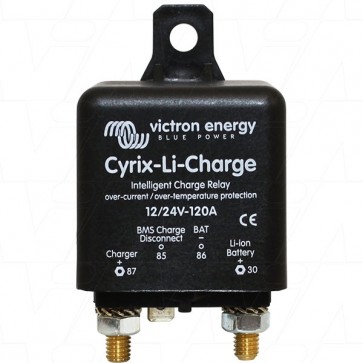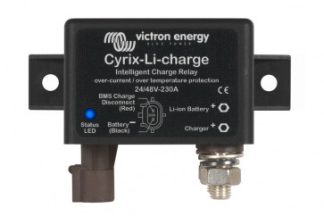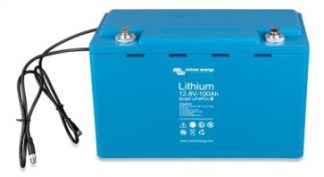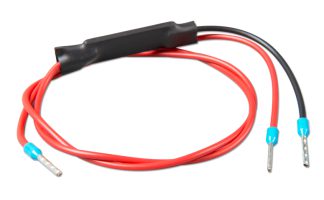Description
Victron Cyrix-Li-Charge 12/24V-120A intelligent charge relay
Microprocessor controlled heavy duty relay that automatically connects batteries in parallel when one of them has reached a pre-set voltage (indicating that the battery is being charged), and disconnects when the voltage decreases below float level (indicating that one or more batteries are being discharged). Cyrix Battery Combiners are an excellent replacement for diode isolators.
The LiFePO4 battery: preventing cell under voltage, over voltage and over temperature
The first line of protection is cell balancing. All Victron LiFePO4 batteries have integrated cell balancing. The second line of protection consists of:
shut down of the load in case of imminent cell under voltage, and
shut down or reduction of the charging current in case of imminent cell over voltage, high temperature (>50°C) or low temperature (<0°C).
The VE.Bus BMS is the core of the second protection line. However, not all loads or chargers can be controlled directly by the VE.Bus BMS. In order to shut down such loads or chargers several VE.Bus BMS controllable Cyrix switches are available.
Cyrix-Li-Charge
The Cyrix-Li-Charge will connect a battery charger with 3 seconds delay:
if the Charge Disconnect output of the VE.Bus BMS is high, and
if it senses 13,7V (resp. 27,4V or 54,8V) or more on its battery charger connection terminal, and
if it senses 2V or more on its battery terminal (the Cyrix will remain open, if not connect to the battery). The Cyrix-Li-Charge will disengage immediately whenever its control input becomes free floating, signalling cell over voltage or cell over temperature.
In general a cell over voltage alarm will reset shortly after charging has been stopped. The Cyrix will then reconnect the charger after a delay of 3 seconds. After two attempts to reengage with 3 seconds delay, the delay increases to 10 minutes.
Whenever battery voltage is less than 13,5V (resp. 27V or 54V), the Cyrix will disengage with a delay of 1 hour.
Note 1: In case of zero discharge current, or a small discharge current, the Cyrix will not disengage shortly after the charger has been switched off and/or disconnected, because battery voltage will remain higher than 13,5V.
Note 2: If, after the Cyrix has disengaged, the output of the battery charger immediately increases to 13,7V or more, the Cyrix will re-engage, with 3 seconds delay.
A built-in transient voltage suppressor will limit the voltage spike that may occur when the Cyrix suddenly disengages due to cell overvoltage or over temperature.



